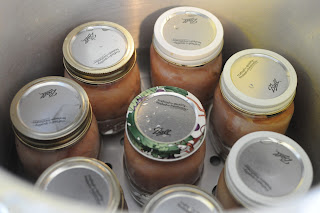Using Your Food Storage- Split Pea Soup

My family always has ham for our Christmas Eve dinner and my mom gives me the ham bone and some of the extra meat if I promise to make my Split Pea Soup to share with her.
Like any good soup recipe, it is easy to make but I wouldn't recommend trying to make this soup unless you were going to be home all morning.
Ingredients
2 C. dried split peas
2 quarts cold water
1 ham bone
1 onion, quartered
1 teaspoon salt
1/2 teaspoon ground black pepper
1/4 tsp dried marjoram and/or thyme
1 bay leaf
1 big clove garlic
3 stalks celery with leaves, halved
2 carrots halved
1 1/2- 2 C. left-over ham, cubed
2 C. celery, chopped (optional)
2 C. carrots, chopped (optional)
Directions
1.
In a large stock pot, combine ham bone with garlic, onion quarters, celery and carrot halves, marjoram, bay leaf, salt and pepper. Cover with water (about 2 quarts) and simmer for 1 hour.
Meanwhile...

Rinse and sort split peas. It is fine if you have some that are yellow. That is natural. You want to look for any shriveled up ones or things that just don't look like they belong. I've found things that look like little pieces of grass or hay before.
Set Aside. (Most split peas don't need to be presoaked but check your package. If they do, stick them in a stock pot, bring to a boil for 2 minutes then remove from heat to soak for an hour while your ham bone simmers.)
A word about organic.
I'm not a huge proponent of organic food. I used to be really anti, thinking it was just a trend people were going through. Call me stubborn but I hate fads. To the point where I do the opposite just to prove a point. But, as I've become a mother and have made all of my daughter's baby food, I have become more concerned with what is in the food I am feeding her.
There are somethings that I think are worthwhile to get organic versions of. Besides organic bananas, which I just think taste better and don't leave a film in your mouth, these peas were my very first organic product I ever bought.
I was in the store wanting to stock up on some split peas and I noticed that the organic version was on sale for about the same price as the regular split peas. I decided to check the nutrition information on the back of the bags and was very surprised when for the same serving size and carbohydrate amount, the organic version delivered almost twice the protein and fiber.
I know it isn't supposed to make a difference nutritionally whether you eat conventional or organic foods. People are more concerned with their carbon footprint and their foods being genetically modified or having residues of pesticides and fertilizers on them. With split peas though, I could see the nutritional difference was clear. So I bought the organic version.
Sorry, back to the recipe.
2.

After 1 hour of simmering, add sorted peas. You may need to add more water to keep everything covered. Simmer for 45 minutes- 1 hour.
3.

Check to see if your peas are cooked and soft. If so, remove ham bone and bay leaf. Working in batches, blend your soup til it is velvety smooth (or use an immersion blender). I even blend up the celery, carrots and onions to give the soup a richer flavor and I figure it doesn't hurt to keep all the nutrients in there.
4.
Return everything to the stock pot and add the chopped carrots and celery. These aren't really necessary since the flavors are already in the broth. I like to have pieces to chew while I'm eating the soup. You could just chop up the celery and carrots that were used to flavor the broth but for me, they would be too mushy so I just add more. Cook slowly for 30 minutes more until veggies are tender.
5.

Cut any good meat off the bone and add that as well as the other pieces of ham back to soup in the last 10 minutes to heat through. Adjust seasonings to taste.
Serve with crusty rolls and enjoy!
TIP: you can do all this in a crockpot too. Layer ingredients in slow cooker in the order given; pour in water. Do not stir ingredients. Cover and cook on HIGH 4 to 5 hours or on low 8 to 10 hours until peas are very soft and ham falls off bone. Remove bone and bay leaf. Mash peas to thicken more, if desired.























































0 comments: